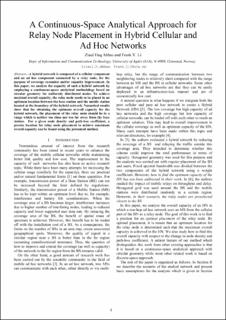| dc.contributor.author | Abbas, Ziaul Haq | |
| dc.contributor.author | Li, Frank Yong | |
| dc.date.accessioned | 2010-02-12T13:35:05Z | |
| dc.date.issued | 2009 | |
| dc.identifier.citation | Abbas, Z. H. & Li, F. Y. (2009). A continuous-space analytical approach for relay node placement in hybrid cellular and ad hoc networks. In Proceedings of the International Symposium on Wireless Communication Systems. IEEE. | en |
| dc.identifier.isbn | 978-1-4244-3584-5 | |
| dc.identifier.issn | 2154-0225 | |
| dc.identifier.uri | http://hdl.handle.net/11250/137746 | |
| dc.description.abstract | A hybrid network is composed of a cellular component and an ad hoc component connected by a relay node, for the purpose of coverage extension and/or capacity improvement. In this paper, we analyze the capacity of such a hybrid network by employing a continuous-space analytical methodology based on circular geometry for uniformly distributed nodes. To achieve maximal overall capacity, the relay node needs to be placed in an optimum location between the base station and the mobile station located at the boundary of the hybrid network. Numerical results show that for obtaining the optimum overall capacity for the hybrid network, the placement of the relay node should be in a range which is neither too close nor too far away from the base station. For a given node density and path-loss coefficient, a precise location for relay node placement to achieve maximum overall capacity can be found using the presented method. | en |
| dc.format.extent | 356446 bytes | |
| dc.format.mimetype | application/pdf | |
| dc.language.iso | eng | en |
| dc.publisher | IEEE | en |
| dc.title | A continuous-space analytical approach for relay node placement in hybrid cellular and ad hoc networks | en |
| dc.type | Journal article | en |
| dc.type | Peer reviewed | en |
| dc.rights.holder | © 2009 IEEE | |
| dc.rights.holder | Personal use of this material is permitted. However, permission to reprint/republish this material for advertising or promotional purposes or for creating new collective works for resale or redistribution to servers or lists, or to reuse any copyrighted component of this work in other works must be obtained from the IEEE. | |
| dc.subject.nsi | VDP::Technology: 500::Information and communication technology: 550::Telecommunication: 552 | en |
| dc.source.pagenumber | 408-412 | en |
| dc.source.journal | Proceedings of the International Symposium on Wireless Communication Systems | |
| dc.identifier.doi | http://dx.doi.org/10.1109/ISWCS.2009.5285305 | |
